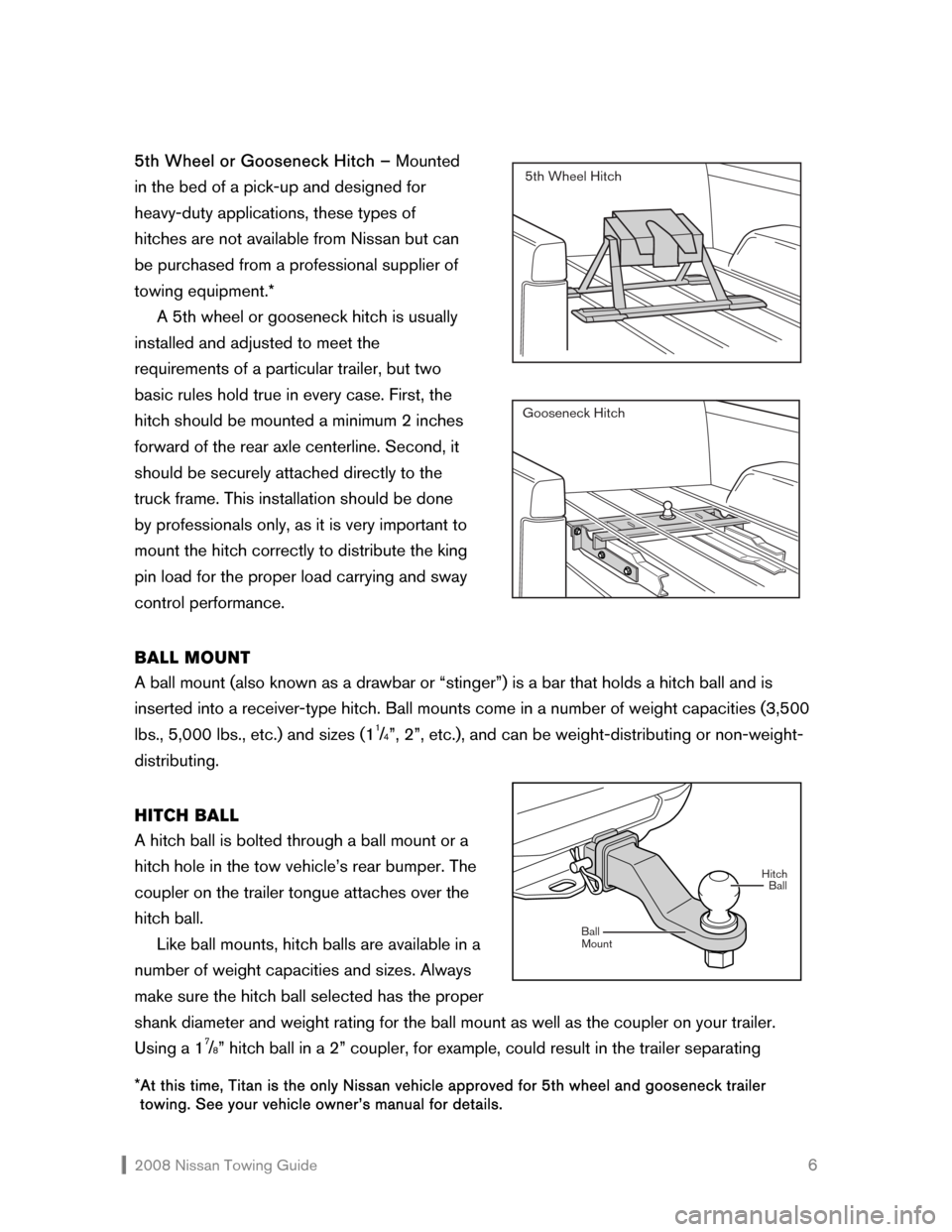2008 NISSAN QUEST ECU
[x] Cancel search: ECUPage 4 of 32

2008 Nissan Towing Guide 3 Your vehicle owner’s manual should ALWAYS be referenced before making any towing
decisions.
Naturally, you will want to buy the highest-quality equipment you can find for maximum
towing safety. And if you plan to tow often, consider convenience. Quick-disconnect trailer
light connectors and ratchet-type tie-downs, for example, make the job go faster and easier
and are usually worth the extra small investment. Purchase towing items such as hitches and
hitch balls only from your Nissan dealer or a professional supplier of towing equipment.
If you are intending to use your vehicle to tow a trailer you already own, you must ensure
that your loaded trailer remains well within your vehicle's towing capacity as specified in the
vehicle owner's manual. In addition, you should purchase the right type, style, and class* of
hitch and towing equipment to properly adapt the trailer to your vehicle.
WHAT’S
RIGHT FOR YOU
TYPES OF EQUIPMENT
Towing requires a variety of equipment, and, depending upon the application, there can be
several types or styles of each piece of equipment. Working with your Nissan dealer or a
professional supplier of towing equipment, it should be relatively simple to determine the
proper type of equipment for your specific vehicle given the intended application. This section
explains the most common pieces of towing equipment available.
HITCHES
Whichever type of hitch you use, it should be firmly bolted to your vehicle, and should be of
the appropriate weight class for the equipment you intend to tow. In addition, keep the
following in mind:
�Š Do not modify the vehicle’s braking or exhaust systems or its body structure/frame when
installing the hitch.
�Š Be sure that the hitch does not interfere in any way with the vehicle’s impact-absorbing
bumper.
�Š Regularly check to see that all hitch-mounting bolts are securely fastened.
�Š Where practical, remove the hitch when not in use. Your Nissan dealer can assist you in
hitch removal and reinstallation.
*See the SPECIFICATIONS section of this guide for equipment class information specific to your
vehicle.
Page 5 of 32

2008 Nissan Towing Guide 4 �Š For receiver-type hitches using a ball mount, the ball mount should be removed when not
towing.
�Š If you install a hitch yourself, remember that it must be securely attached to the frame or
underbody, according to the manufacturer’s instructions. Never attach a hitch or towing
device to the vehicle axle housing. This may damage the housing, wheel bearings,
wheels, or tires.
Hitch Types
Bumper Hitch – This is a special reinforced
bumper designed to accommodate a hitch
ball.
Receiver Hitch – A receiver hitch is bolted
directly to the vehicle structure for added
strength and durability. Nissan bolt-on
receiver hitches are designed specifically for
Nissan vehicles and include the necessary
reinforcements, with ample clearance around
bumpers, frame members, etc. These hitches
allow for the removal of the ball mount when
not towing.
Page 7 of 32

2008 Nissan Towing Guide 6 5th Wheel or Gooseneck Hitch – Mounted
in the bed of a pick-up and designed for
heavy-duty applications, these types of
hitches are not available from Nissan but can
be purchased from a professional supplier of
towing equipment.*
A 5th wheel or gooseneck hitch is usually
installed and adjusted to meet the
requirements of a particular trailer, but two
basic rules hold true in every case. First, the
hitch should be mounted a minimum 2 inches
forward of the rear axle centerline. Second, it
should be securely attached directly to the
truck frame. This installation should be done
by professionals only, as it is very important to
mount the hitch correctly to distribute the king
pin load for the proper load carrying and sway
control performance.
BALL MOUNT
A ball mount (also known as a drawbar or “stinger”) is a bar that holds a hitch ball and is
inserted into a receiver-type hitch. Ball mounts come in a number of weight capacities (3,500
lbs., 5,000 lbs., etc.) and sizes (1
1/4”, 2”, etc.), and can be weight-distributing or non-weight-
distributing.
HITCH BALL
A hitch ball is bolted through a ball mount or a
hitch hole in the tow vehicle’s rear bumper. The
coupler on the trailer tongue attaches over the
hitch ball.
Like ball mounts, hitch balls are available in a
number of weight capacities and sizes. Always
make sure the hitch ball selected has the proper
shank diameter and weight rating for the ball mount as well as the coupler on your trailer.
Using a 1
7/8” hitch ball in a 2” coupler, for example, could result in the trailer separating
*At this time, Titan is the only Nissan vehicle approved for 5th wheel and gooseneck trailer
towing. See your vehicle owner’s manual for details.
5th Wheel Hitch
Gooseneck Hitch
Hitch
Mount BallBall
Page 16 of 32

2008 Nissan Towing Guide 15 Always make sure your vehicle’s towing capacity is adequate for the trailer you intend to tow.
Buy or lease only quality equipment, and have it installed only by professionals. In addition, be
certain that you have all of the equipment needed for safe towing, including safety
chains/cables, electric trailer brakes, electric trailer brake controller, breakaway switch,
extended rear view mirrors, and so on. All of these items have been discussed in a previous
section of this guide.
With regard to vehicle maintenance, you should follow a more frequent schedule and
check fluid levels, pressures, tire condition, etc., more often when on the road. See your
vehicle owner’s manual for details.
LOADING YOUR TRAILER
Taking the time to load and balance your trailer properly will improve overall handling and
minimize the strain on your tow vehicle. Incorrectly loaded trailers tend to sway or swing from
side to side, upsetting vehicle handling. Careful loading and balancing can help eliminate
these problems.
As mentioned earlier, conventional trailer tongue load must fall between 10-15% of the
total trailer weight. King pin load — if using a 5th wheel or gooseneck trailer — must be
between 15-25% of the total trailer weight.
Excessive tongue/king pin load can actually
push down the vehicle in back, lifting the front
wheels to a point where traction, steering
response, and braking are severely reduced.
Insufficient tongue/king pin load can cause
instability, which may lead to “tail wagging” or
jackknifing.
With this in mind, proper loading is extremely
important. When loading a trailer, 60% of the
total cargo weight should be positioned in the
front portion of the trailer and 40% in the back.
Then, the load should be adjusted until the proper
tongue/king pin load ratio is achieved.
The trailer load should be balanced equally
from side-to-side. Unequal side-to-side loading
can negatively affect handling and braking. Once
in place, all cargo should be firmly secured to
prevent shifting. If the load should shift abruptly
during braking or cornering, it could quickly affect
Page 18 of 32

2008 Nissan Towing Guide 17 limits described in this guide. These changes may diminish the reliability and longevity of your
vehicle and possibly void warranty coverage.
TOOL KIT
It is always a good idea to travel with a special tool kit when towing. In addition to tools, it
should contain flares, a flashlight, emergency reflectors, jumper cables, extra fuses, extra
radiator coolant, oil, and easily replaced spare parts such as taillight bulbs. You should also
carry spare tires for your tow vehicle and trailer, as well as a jack suitable for use on the trailer.
Be aware that not all automotive jacks can be used safely on a trailer.
BEFORE STARTING OUT
Before starting out on a trip, make one last inspection of the tow vehicle and the trailer. Are
the tire pressures correct? Are the safety chains/cables securely in place? Is the cargo tied
down securely? Do all the lights work? Is the coupler properly attached over the hitch ball and
secured using a locking pin? Is the breakaway switch hooked up and functioning properly?
Are vehicle and electric trailer brakes working properly?
Make a checklist of key items to be inspected, and don’t forget the basics. When towing,
vehicle engine oil, transmission oil, and coolant should always be checked before starting out.
Finding a potential problem while in your driveway is better than discovering it miles from
home.
TOWING
TIPS
If you’ve never towed a trailer before, be aware that it does take getting used to. To begin with,
towing noticeably affects your vehicle’s performance:
�Š It will not accelerate as quickly — an important point to keep in mind when merging onto a
highway.
�Š It will not stop as quickly. Leave more room than usual between you and the traffic ahead,
and brake sooner when coming to a stop.
�Š Abrupt maneuvering can unbalance the load and reduce the handling stability of your tow
vehicle. Plan ahead and make lane changes and turns smoothly.
If possible, before you actually hit the open road, practice towing in a large uncrowded area
such as a stadium or shopping center parking lot. Become especially familiar with backing up
a trailer — the maneuver many people find most difficult.
Page 30 of 32

2008 Nissan Towing Guide 29 TOW VEHICLE WIRING HARNESSES
PROTECTION
At Nissan, we back everything we build. So we’re proud that every Nissan is protected by
some of the best New Vehicle Limited Warranties, including 36-month/36,000-mile basic
coverage. All 2008 models also feature 60-month/60,000-mile powertrain coverage.** And,
Nissan warranties are completely transferable if you should sell your Nissan.
If you want additional peace of mind, we proudly offer the Nissan Security+Plus
® Vehicle
Protection Plan. This plan offers quality mechanical protection long after your New Vehicle
Limited Warranty expires.
The Security+Plus Vehicle Protection Plan is backed by Nissan and designed exclusively
for Nissan owners. From a variety of plans available, you can choose the one that best fits your
*Available only for SL models equipped with Manual Shift Mode.
**For complete warranty details, read the Nissan Warranty Information Booklet or see your nearest
Nissan dealer.
Harness Type Trailer Lighting Electric Trailer Brakes
Armada 7-pin connector wiring harness LE: Pre-wired SE: Tow harness kit available
Receiver hitch: 7-pin connector wiring harness
Pre-wired with 7-pin harness. Requires an electric trailer brake controller (supplied by customer), and an electric trailer brake controller wiring harness (included with vehicle or available from Nissan dealer).
Frontier
4-pin connector wiring harness
Tow harness kit available
Standard equipment: 4-pin connector wiring harness
N/A
Pathfinder
7-pin connector wiring harness
Tow harness kit available Pre-wired with 7-pin harness. Requires an electric trailer brake controller (supplied by customer), and an electric trailer brake controller wiring harness (included with vehicle or available from Nissan dealer).
Quest 4-pin connector wiring harness Available in factory tow package
Rogue 4-pin connector wiring harness SL: Tow harness kit available*
N/A
Titan 7-pin connector wiring harness Pre-wired
Xterra Receiver hitch: 7-pin connector wiring harness Tow harness kit available
Pre-wired with 7-pin harness. Requires an electric trailer brake controller (supplied by customer), and an electric trailer brake controller wiring harness (included with vehicle or available from Nissan dealer).
Page 31 of 32

2008 Nissan Towing Guide 30 driving needs (up to 84 months/100,000 miles!). For the maximum coverage, you will want to
opt for Security+Plus Gold
® Preferred.
Whichever plan you choose, coverage is available throughout the United States. Repair
work will be done at authorized Nissan dealers by Nissan-trained technicians utilizing Genuine
Nissan Parts. For more information about Security+Plus Vehicle Protection Plans, contact
your participating Nissan dealer.
The quality of Genuine Nissan Parts and Accessories is backed by the integrity of a
Genuine Nissan Replacement Parts and Accessories Limited Warranty. If purchased within
the basic coverage period of 36 months/36,000 miles, Genuine Nissan Parts and
Accessories are covered by the remaining period of the warranty. If the remaining period is
less than 12 months/12,000 miles (or if the vehicle warranty has expired), then Genuine
Nissan Accessories are covered by their own 12-month/12,000-mile Limited Warranty. See
your Nissan Warranty Information Booklet or ask your Nissan dealer for specific details.
CONCERN FOR YOUR SAFETY
Nissan urges you to always use your seat belt whenever you drive. And please make sure all
passengers are buckled up. Keep in mind that air bags are a supplemental restraint system
and must always be used in conjunction with a seat belt.
In addition, a rear-facing child restraint must never be used in the front passenger seat if
the vehicle is equipped with a front passenger air bag. Children 12 and under should ride in
the rear seat properly secured in child restraints, booster seats, or seat belts, according to
their size. See your vehicle owner's manual for more details.
COMMITMENT
At Nissan, our commitment to your satisfaction extends well beyond building a full line of
quality products. It begins with people dedicated to designing vehicles to satisfy your needs.
Then, building them to standards that are beyond your expectations. Our nationwide network
of nearly 1,100 dealers will help you select the Nissan that is right for you.
For further assistance, search our Web site at www.NissanUSA.com. For Nissan dealer
locations or for more information on this and other Nissan products, call 1-800-239-8810. Or
call 1-800-NISSAN-1 for answers to product-related issues and solutions to your
transportation needs.